RFT minirex 75
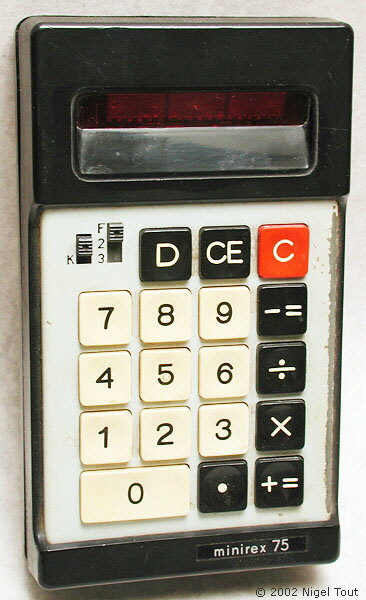
RFT minirex 75
Distinctive features: One of a series of models manufactured in the communist DDR (Deutsche Demokratische Republik [GDR, German Democratic Republic, ie. East Germany]). Batteries recharged by inserting the calculator in the charging unit, which also effectively turns it into a desktop calculator.
Technical details:
Display is 8 digits, red LED.
4-function.
4.8v (4x rechargeable button cells).
Main integrated circuit - Texas Instruments TMS0105NC, here date-coded week 43 of 1973. Has display driver integrated circuits manufactured in the DDR.
81 x 139 x 34 mm (3.2" x 5.5" x 1.3").
Launched in 1976[1].
Manufactured by
VEB Rohrenwerk Mulhausen,
in combination with
VEB Funkwerk Erfurt.
Made in GDR. ["German Democratic Republic", ie. East Germany]
The calculator batteries are recharged by plugging the calculator into the docking station.
The story of the development of the minirex models is told below
The calculator plugged into the charging unit.
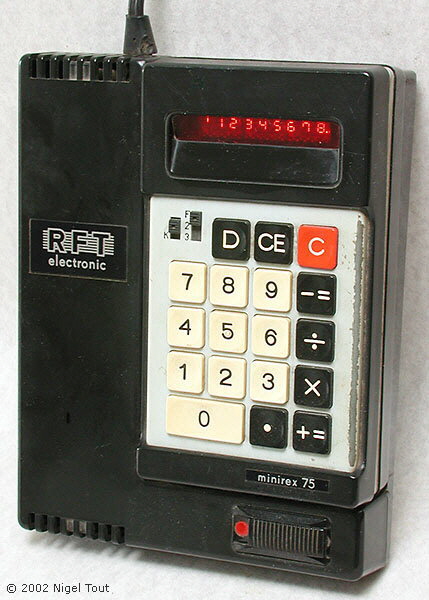
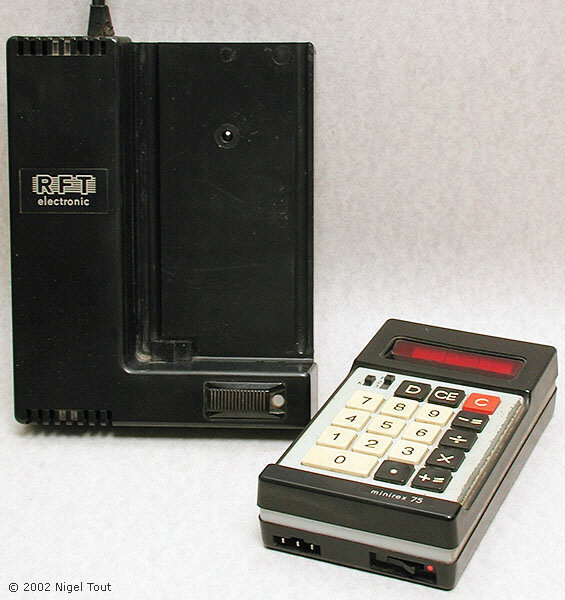
The calculator alongside the charging unit.
On the bottom of the calculator is the plug to connect it to the charging unit, and also the on/off switch.
The calculator is secured to the charging unit by a captive finger screw from the back of the charging unit.
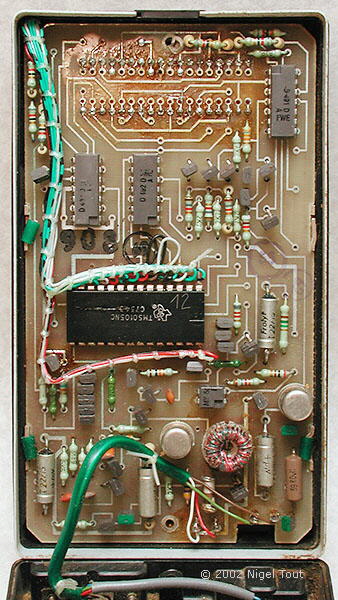
The circuit board with the large Texas Instruments TMS0105NC calculator chip, and three display driver chips (manufactured in the DDR).
Note the wiring has high-quality binding with cord.
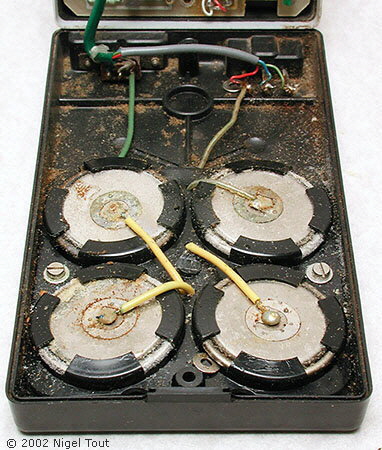
The unusual nickel-cadmium rechargeable button cells, derived from mining lamps.
This calculator is from the middle of the period of the "Cold War", before the fall of the Berlin wall and the reunification of East and West Germany. The communist countries lagged behind in chip technology, as explained below. This minirex 75 model was launched in 1976 and uses a Texas Instruments TMS0105NC calculator chip due to a shortage of an equivalent chip manufactured in the DDR. The TMS0105NC was introduced in 1972 (see, for example, the Busicom LE-80A) and by this time was obsolescent. It can be seen that in the example above the chip is date coded week 43 of 1973 so, being over two years old by the time that this calculator was manufactured, may have been 'new-old-stock'.
Note that the binding of the wiring with cord is not something that was cost effective in a capitalist economy, but this feature of high-quality industrial wiring has been used in this product of a command economy.
The use of a docking unit seems a very logical and neat idea, yet was very rarely used elsewhere. The Advance 88 is another example, but the docking unit for that model is not so elegant.
The development of the minirex models
The story of the development of the minirex models, below, is extracted from "Die Ersten und die
Letzten – 18 Jahre Taschenrechner aus Mülhausen [The first and the last - 18 years of calculators from Mulhouse]"[1]: and "Zur Entwicklung des Taschenrechners minirex 73 in Erfurt [The development of the Minirex 73 calculator in Erfurt]"[2]., both published by Thuringian Museum of Electrical Engineering e. V.
At the end of 1971 a business delegation from the DDR (Deutsche Demokratische Republik [GDR, German Democratic Republic]) visited Japan and returned with a Busicom LE-120A, the first truly pocket-sized calculator, which used the Mostek MK6010 'calculator on a chip'. Early in 1972 the Minister of Electrical Engineering and Electronics issued a directive that a pocket calculator was to be developed, initially using imported components to be replaced by locally manufactured components within two years.
However, at that the time the DDR was under Cold-War COCOM regulations which restricted high-technology imports from the Western bloc. This meant that the DDR would have to try to develop the components of the calculator itself. By this date the Bowmar 901B calculator had been launched using the Texas Instuments TMS0105NC 'calculator on a chip', and it was on this calculator and chip that the DDR would base its design, with their chip given the designation U820D.
Before the U820D chip, the LED displays and the driver circuits became available in quantities from domestic production, volume calculator manufacture had to be attained firstly with imported components that were obtained through "creative trading activities", including the TMS0105NC, which bypassed the embargo provisions. Initially the labels on the components were erased to hide this fact.
Since at the beginning of the 1970s no nickel-cadmium batteries in AA size were available in the DDR, NiCd button cells (1.2 V, 500 mA) from a mine lamp factory were used. It was decided to provide the calculator with an AC power adapter into which it docked, which could recharge the NiCd cells and also effectively turn the calculator into a desktop model.
Production was due to commence at Röhrenwerk Mühlhausen in March 1973, and the minirex 73 was launched at the Leipzig Spring Fair in 1973. About 6,000 examples of the minirex 73 were manufactured. However, due to manufacturing and procurement difficulties, the greater part were made using a Mostek chip.
The minirex 73 was superseded by the similar minirex 74 which used the AMI (American Micro-systems Inc.) S2144 chip with the label obscured. With difficulties in obtaining the embargoed S2144 chip, about 15,000 of the minirex 74 were produced.
By the beginning of 1976 large-scale production of the U820D calculator chip was under way and the first calculator solely using components from the DDR was launched - the minirex 75, pictured above. However, since the production rate of the minirex 75 exceeded the production capacity of the U820D calculator chip and the LED displays, a number of calculators were produced using the Texas Instruments TMS0105NC chip or the Mostek MS5020 chip and Litronix LED display modules. The example shown above is one of those using the Texas Instruments TMS0105NC chip.
The cost of the minirex calculators was beyond that of the average person, so they were used initially as small desktop calculators in companies, research institutions, and administration departments.
In order to produce a more affordable calculator the Koncret 100 and 200 models were designed, based on the U821D calculator chip which required fewer additional components.
References:
- Lorenz, H., "Die Ersten und die Letzten – 18 Jahre Taschenrechner aus Mülhausen [The first and the last - 18 years of calculators from Mulhouse]", ON.LINE, Thuringian Museum of Electrical Engineering e. V., pp6-11, https://www.elektromuseum.de/publication/newsletter/elektromuseum_newsletter_032018.pdf.
- Hloucal, S., "Zur Entwicklung des Taschenrechners minirex 73 in Erfurt [The development of the minirex 73 calculator in Erfurt]", ON.LINE, Thuringian Museum of Electrical Engineering e. V., pp16-19, https://www.elektromuseum.de/publication/newsletter/elektromuseum_newsletter_042018.pdf.
Hand-held Calculators
Vintage Calculators
Text & photographs copyright, except where stated otherwise, © Nigel Tout 2000-2026.